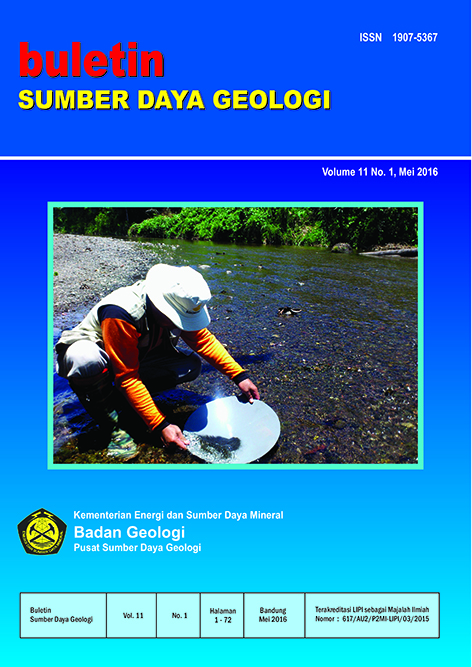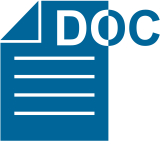PENDEKATAN STATISTIK MULTIVARIAT TERHADAP DATA GEOKIMIA TANAH MULTI-UNSUR UNTUK MENGIDENTIFIKASI MINERALISASI Au-Cu EPITERMAL SULFIDA TINGGI DI DAERAH PROSPEK "X", KECAMATAN BATANG ASAI, KABUPATEN SAROLANGUN, PROVINSI JAMBI
Abstrak
Analisis statistik multivariat dilakukan terhadap data analisis kimia multi-unsur conto tanah menutupi endapan mineral yang menempati litologi batuan vulkanik Formasi Hulu Simpang berumur Oligosen Akhir - Awal Miosen, terletak di daerah Prospek "X", Kabupaten Sarolangun, Jambi. Tujuan penelitian ini adalah untuk mengetahui hubungan antara Au dan Cu dengan unsur-unsur lain agar dapat teridentifikasi kemungkinan mineralisasi Au-Cu endapan sulfida tinggi dari data geokimia tanah. Penelitian ini difokuskan pada 12 unsur terdiri Au, Ag, Hg, Te, Sb, As, Bi, Cu, Pb, Zn, Sn, dan Mo. Hasil analisis kimia 376 conto tanah kisi dari daerah penelitian dengan luas berkisar 5,3 km2 disajikan dengan menggunakan statistik multivariat yang terdiri analisis korelasi dan analisis klaster hirarki. Kedua metode statistik multivariat tersebut mengindikasikan kompilasi hasil analisis yang bersifat representatif yaitu Klaster I Cu-As-Sb-Te dengan nilai korelasi berkisar 0.50-0.93 dan Klaster II Au-Bi dengan nilai korelasi 0.26; adapun yang bersifat tidak representatif yaitu Klaster III Pb-Mo-Zn dengan nilai korelasi berkisar 0.09-0.10 dan Klaster IV Sn-Hg-Ag dengan nilai korelasi berkisar 0.02-0.25. Klaster I dan II berkaitan dengan kumpulan asosiasi unsur indikasi mineralisasi Au-Cu epitermal sulfida tinggi. Daerah mineralisasi ini tersusun oleh ubahan argilik lanjut dari breksi vulkanik, tuf, andesit, dan dasit; serta dicirikan oleh kehadiran mineral bijih enargit, luzonit, kalkopirit, arsenopirit, dan kovelit.
##plugins.generic.usageStats.downloads##
Referensi
Amor, S., 2011, Data Presentation and Interpretation Requirements for Geochemical Exploration, Consultant, Burlington.
Darman, H., and Sidi, F.H., 2000, An Outline of The Geology of Indonesia, Ikatan Ahli Geologi Indonesia, Jakarta.
Davis, J.C., 2002, Statistics and Data Analysis in Geology : Third Edition, Kansas Geological Survey, The University of Kansan, John Wiley & Sons, Inc., New York, 656 p.
Joyce, A.S., 1984, Geochemical Exploration, The Australian Mineral Foundation Inc., Brisbane.
McQueen, K.G., 2002, Identifying Geochemical Anomalies, CRC LEME, Department of Earth and Marine Sciences, Australian National University, Canberra.
Niton, 2012, Application of the Thermo Scientific Portable XRF Analyzer in PGE Exploration, Thermo Fisher Scientific Inc., USA.
Sugiyono, 1999, Statistika Untuk Penelitian, CV. Alfabeta, Bandung.
Suwarna, N., Soeharsono, Gafoer, S., Amin. T.C., Kusnama, dan Hermanto., B, 1992, Peta Geologi Lembar Sarolangun, Sumatera, Skala 1 : 250.000, Pusat Penelitian dan Pengembangan Geologi, Bandung.
Timm, N.H., 2002, Applied Multivariate Analysis, Library of Congress Cataloging-in-Publication Data, Springer-Verlag New York, Inc., New York.
Anonim, 2014, Laporan Akhir Eksplorasi Emas dan Mineral Pengikutnya, daerah Batangasai, Kabupaten Sarolangun, Provinsi Jambi, PT ANTAM Tbk Unit Geomin, Jakarta. Tidak dipublikasikan.
White, N.C., and Hedenquist, J.W., 1995, Epithermal Gold Deposits: Styles, Characteristics, and Exploration, Society of Economic Geologists Newsletter No. 23, p. 9-13.
##submission.copyrightStatement##
##submission.license.cc.by-nc-sa4.footer##Penulis yang naskahnya diterbitkan menyetujui ketentuan sebagai berikut:
Hak publikasi atas semua materi naskah jurnal yang diterbitkan/dipublikasikan dalam situs Buletin Sumber Daya Geologi ini dipegang oleh dewan redaksi dengan sepengetahuan penulis (hak moral tetap milik penulis naskah).
Ketentuan legal formal untuk akses artikel digital jurnal elektronik ini tunduk pada ketentuan lisensi Creative Commons Attribution-ShareAlike (CC BY-SA), yang berarti Buletin Sumber Daya Geologi berhak menyimpan, mengalih media/format-kan, mengelola dalam bentuk pangkalan data (database), merawat, dan mempublikasikan artikel tanpa meminta izin dari Penulis selama tetap mencantumkan nama Penulis sebagai pemilik hak cipta.
Naskah yang diterbitkan/dipublikasikan secara cetak dan elektronik bersifat open access untuk tujuan pendidikan, penelitian, penyelidikan, dan perpustakaan. Selain tujuan tersebut, dewan redaksi tidak bertanggung jawab atas pelanggaran terhadap hukum hak cipta.















